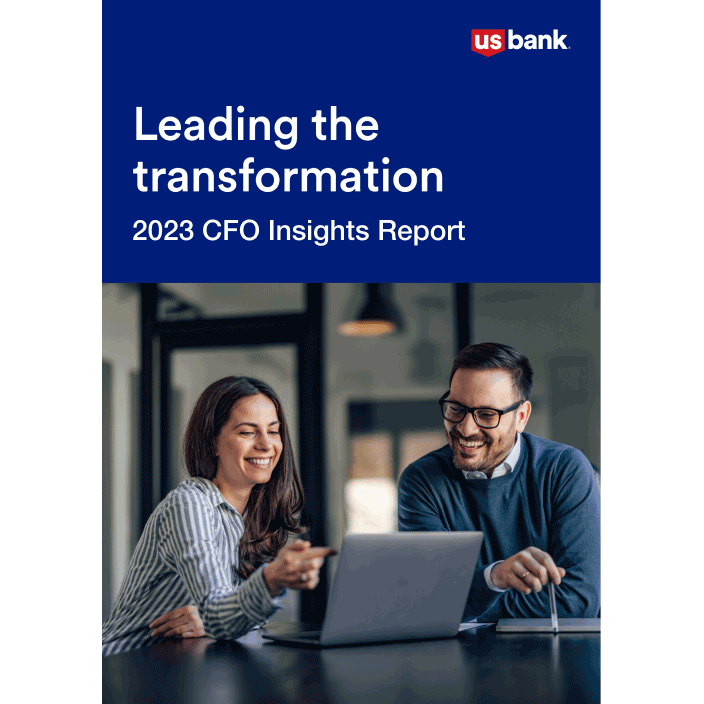
FDIC-Insured - Backed by the full faith and credit of the U.S. Government
Leaders increasingly look to technology for cost savings.
Faced with soaring inflation and rising interest rates, it’s hardly a surprise that many businesses are focusing on cost reduction and efficiencies. However, the methods they are employing to achieve these aims are less orthodox: rather than reducing headcount and overheads, they are investing in digital technology.
That’s one of the key findings of a major new U.S. Bank survey of 1,420 financial leaders at businesses with annual revenue of over $100 million. The survey reveals that finance executives’ top priorities for the next 12 months are cutting costs and driving efficiencies: both within the finance function (identified as a priority by 38%, up from 30% in our 2022 research), and across the organization as a whole (identified by 33%, up from 29% a year ago).
When those executives were asked how they plan to deliver those savings, the most common approach – identified by 45% of respondents – was investment in digital technology. That’s more than double the proportion who are looking to reduce headcount: job cuts are planned by just 19%, down from 22% a year ago and dramatically lower than the 2021 figure (40%).
It’s clear that businesses are counting on the power of digital technology to deliver transformative results. However, it is equally clear that many businesses have a long way to go to become truly digitally enabled. Forty-five percent of finance leaders surveyed admit they are still in the early stages of digital transformation.
In the race to become digitally enabled, the stakes are high.
Key survey findings
- Finance executives’ top priorities for the next 12 months are cutting costs and driving efficiencies.
- Digital technology is the most common approach to delivering savings.
- Forty-five percent of finance leaders surveyed admit they are still in the early stages of digital transformation.
- The greatest obstacles to progress on digital change initiatives include a lack of awareness of technology and its potential benefits.
People, process and technology drive digital transformation.
Vipul Kaushal, senior vice president and global product manager of digital transformations at U.S. Bank, explains some of the most important things organizations should prioritize along the journey toward transformation.
Four steps to improving the odds of a successful digital transformation
1. Partner with innovation teams to access digital expertise.
In most cases, successful digital transformations in finance are based on a simple principle: recognizing that the finance team on its own is unlikely to have the capability to transform itself, and it will need to find partners that can help.
“Finance functions have a very specific skillset,” explains Vipul Kaushal, U.S. Bank Global Treasury Management senior vice president and head of Digital Transformation. “And for good reason – they're there to manage cashflow for the firm, deliver forecasts, and manage the books on an ongoing basis. However, in most cases, they do not have the skillset needed to digitally transform what they’re doing.”
Kaushal’s point is confirmed by the survey data: the biggest obstacles to quicker progress on digital change initiatives include a lack of awareness of finance technology and its potential benefits (identified by 34% of finance leaders), and a lack of skills or personnel to implement and use new technologies (33%).
The most viable solution is partnership with the organization’s innovation or digital teams. These teams are at the forefront of exploration of new tools and technologies, building different use cases and developing proofs-of-concept to implement across the business. For finance executives, tapping into that expertise is essential to accelerating digitalization.
2. Implement an agile and inclusive change process.
As finance teams work with innovation and digital colleagues, they must take care to nurture effective relationships. The model needs to be a true partnership, where finance personnel work closely and equally with their digital colleagues to develop and deploy solutions.
That means ditching the traditional approach to software development and digital solutions – the so-called waterfall methodologies, under which the finance team specifies their requirements and the digital team develops product solutions to order.
In today's fast-changing business environment, this approach just isn't viable. Months could pass between the definition of requirements and delivery of a solution and it is highly likely that, in the interim, needs will change as the business evolves. Plus, if businesses exclude end-users from the development process, resistance to change becomes more likely.
This is where agile methodologies have the edge, explains Vipul Kaushal. “The process of change needs to be agile, iterative and inclusive, allowing finance teams to be involved in designing and testing new systems. With an agile approach, solutions can be iterated to ensure they work as required, even if needs change – and leaders can build greater buy-in across their teams ahead of rolling out solutions more widely.”
3. Define the use case to secure resources.
Inevitably, innovation requires resources. However, in back-office functions such as finance, it can be hard to build a business case for investment. “Finance is not a profit center, so it’s often tough to secure funding to do something innovative,” concedes Kaushal. In the U.S. Bank survey, 32% of executives say that lack of funding is a major obstacle to digital initiatives, making it a top-five concern.
This is another reason why finding the right partnerships can be crucial. The recent creation of chief digital officer (CDO) roles in many firms has typically been backed by budget that allows finance executives, in partnership with colleagues, to develop use cases across the business, whether as part of an efficiency drive or to further strategic aims.
For example, forecasting processes, particularly in large and complex firms, frequently remain heavily reliant on spreadsheets. Such a framework can be highly time-consuming. A digitally enabled solution can deliver substantial savings in terms of working hours, as well as improving the forecasting system itself.
Alternatively, the right partnership might mean framing the use case in terms of the company’s wider digital or customer-experience strategies. No business can deliver a great digital customer experience if its finance function is stuck in the past and continues to insist on traditional paper-based money movement.
4. Make speed and convenience the guiding stars for change.
Fears about the impact of digital business transformation can quickly spark resistance. Indeed, the new U.S. Bank research reveals that the single most commonly perceived obstacle to quicker progress on digital finance transformation initiatives is employee reluctance and resistance to change, identified by 40% of executives.
To overcome that reluctance, executives need to allay fears that digital technology will mean job losses. Instead, underline the support it will offer to employees, making their working lives more convenient and interesting, freeing them up to participate in more strategic and creative projects, thereby increasing job satisfaction.
The success of Amazon, Apple and Uber is based on driving radical changes in consumer behavior through the offer of greater convenience, simplicity, and intuitive products and services. The same principle applies to digital change initiatives. “Employees will embrace change if it benefits them,” agrees Vipul Kaushal. “Engagement and adoption of technology across the finance function will be higher if it improves convenience.”
That creates a win-win situation, where technology helps executives control costs while simultaneously enhancing the finance function’s contribution to the business, and reinforcing employee engagement.
A more efficient future?
Given the continuing unstable economic outlook, businesses are likely to maintain focus on costs and efficiencies for some time. The good news is that this instability could prove the catalyst for a more streamlined, digitally enabled future, where business technology and people resources are used in the most effective and efficient ways possible, to the benefit of employees and the business.
More Resources
Stay Connected
“Employees will embrace change if it benefits them. Engagement and adoption of technology across the finance function will be higher if it improves their convenience.”
Vipul Kaushal, SVP/Head of Digital Transformation
U.S. Bank Global Treasury Management

Read the full 2023 CFO Insights Report.
Digital transformation is just one of the many topics covered in this year’s CFO Insights Report. The full report dives deep into four ways finance leaders intend to transform their companies, from cost control to tech to risk to digital payment adoption. With responses from more than 1,400 finance leaders, you’re sure to find valuable insights to inform your own decisions.
Read more from our research.

Healthcare Insights
Cost savings a priority for healthcare finance leaders

Payments Insights
Instant payments use on the rise

California Report
See California-specific research.

Economic Insights

